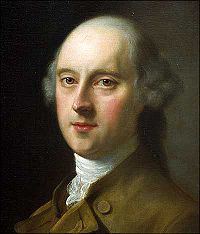Died July 15, 1801 Name William 2nd | Monarch George III Spouse Frances Nicoll (m. 1755) | |
 | ||
Prime Minister The Marquess of Rockingham Preceded by The Earl of Hillsborough Preceded by The Earl of Hillsborough Succeeded by Wills Hill, 1st Marquess of Downshire Books The Manuscripts of the Earl of Dartmouth Similar People Eleazar Wheelock, George III of the United Ki, Jim Yong Kim | ||
William legge 2nd earl of dartmouth
William Legge 2nd Earl of Dartmouth PC, FRS (20 June 1731 – 15 July 1801), styled as Viscount Lewisham from 1732 to 1750, was a British statesman who is most remembered for his part in the government before and during the American Revolution, and as the namesake of Dartmouth College.
Contents

Background
Dartmouth was the son of George Legge, Viscount Lewisham (d. 1732), son of William Legge, 1st Earl of Dartmouth. His mother was Elizabeth, daughter of Sir Arthur Kaye, 3rd Baronet. Having entered Trinity College, Oxford, in 1748, he succeeded his grandfather in the earldom in 1750.
Political career
Lord Dartmouth was Secretary of State for the Colonies from 1772 to 1775. It was Lord Dartmouth who, in 1764, at the suggestion of Thomas Haweis, recommended John Newton, the former slave trader and author of "Amazing Grace", to the Bishop of Chester, and was instrumental in his being accepted for the Anglican ministry.
In 1772, in correspondence with Sir William Johnson, the Superintendent of Northern Indian Affairs in America, he suggested there was no reasonable way the British Government could support new trade regulations with the Indians. He sympathised with Johnson's arguments but stated the Colonies did not seem inclined to concur with any new regulations.
Philanthropy
Lord Dartmouth was a large donor to and the leading trustee for the English trust that would finance the establishment of the Moor's Charity School, in Lebanon, Connecticut by Eleazar Wheelock to educate and convert the Indians. Wheelock subsequently founded Dartmouth College in Hanover, New Hampshire, naming the school in Lord Dartmouth's honour in hopes of getting his financial support. Lord Dartmouth refused. In London, Lord Dartmouth supported the new Foundling Hospital, a charitable institution for the care and maintenance of London's abandoned children. He served as a vice-president of the organisation from 1755 until his death. The famous painter Sir Joshua Reynolds painted the Earl's portrait and donated it to the hospital. The portrait is still in the Foundling Hospital Collection and can be seen at the Foundling Museum in London. He was admitted a Fellow of the Royal Society on 7 November 1754.
Family
Lord Dartmouth married Frances Catherine, daughter of Sir Charles Gounter Nicoll, in 1755. Their younger sons Admiral the Hon. Sir Arthur Kaye Legge and the Right Reverend the Hon. Edward Legge, Bishop of Oxford, both gained distinction. Their daughter Charlotte married Charles Duncombe, 1st Baron Feversham.
He died at Blackheath, Kent, on 15 July 1801, in the seventy-first year of his age, and was buried in Trinity Church in the Minories on 3 August 1801. He was succeeded by his eldest son, George. Lady Dartmouth died in July 1805. The family lived at Sandwell Hall (since demolished) in the Sandwell Valley.
